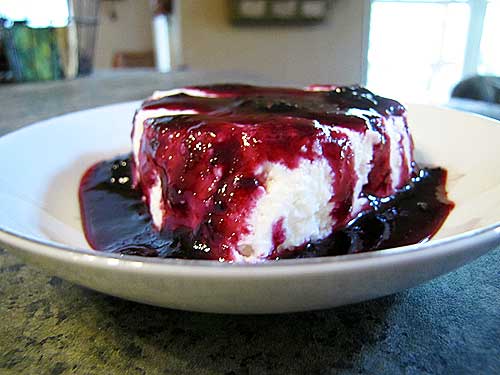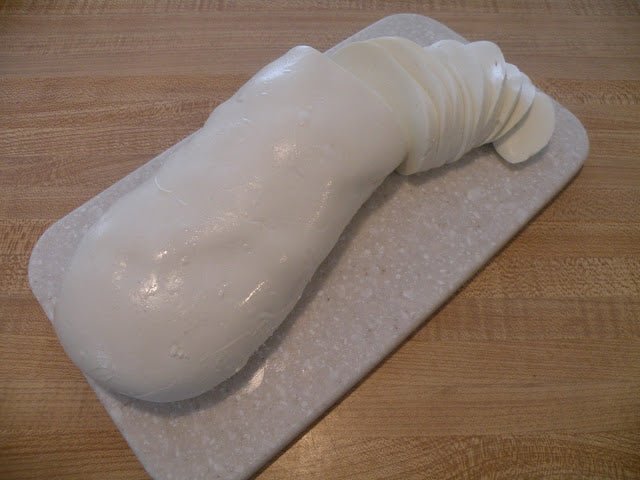
Another challenge met!
By Suzanne McMinn at Chickens in the Road
This month, as part of my ever adventurous cheese challenge for New England Cheesemaking, I’m taking part in NEC’s month-long celebration of the Cheese Queen’s wedding with the sweet, the delicious, and the romantic Coeur a la Creme. (Note: Ricki and Jamie were married August 21, 2011.)
By the way, do you think the groom gets to be the Cheese King now? Or the Cheese Prince Consort? Will they cut the cheese instead of the cake? Will they drive away in a cheesemobile? Will they honeymoon on the Isle of Brie and be hand-fed crackers by Keebler elves? Do these and many other such questions explain why I have no wedding invitation? Were you invited? No? Ricki? Ricki! We love you! Oh never mind.
But, hark! Lo and although we have no ticket to the cheese castle, we can take part in the fun! It all starts with fromagina, Ricki Carroll’s own unique soft cheese concoction. Fromagina is a cross between fromage blanc and mascarpone. It delivers a rich, creamy cheese that is perfect for sweet and savory spreads as well as dessert recipes. It’s also sinfully simple to make. (Fromagina comes as a direct-set culture and is available from New England Cheesemaking.) It’s a perfect soft cheese to use for Coeur a la Creme in these adorable heart-shaped molds.
We’re headed here:
This cheese is best made with farm-fresh or local milk, either slow-pasteurized (at 145 degrees for 30 minutes) or used raw. If you’re using pasteurized store-bought milk, add 1/2 teaspoon calcium chloride directly to the milk when you put it in the pot. Do NOT use ultra-pasteurized milk.
How to make Fromagina:
1 gallon whole milk
1 direct-set packet fromagina starter
Heat the milk to 86 degrees (F). Add the starter packet and stir to mix thoroughly. (The culture itself includes rennet, so no additional rennet is required.)
Let the milk set at room temperature, undisturbed, for 12 hours, until it forms a curd.
Ladle into butter muslin and hang to drain for 6-12 hours, or until you achieve your desired consistency. (Less hanging time for a creamier cheese, longer for a more dry cheese.)
That’s it! Refrigerate until ready to serve.
This is possibly the easiest soft cheese in the world, which makes it a great one for beginners.
Now for the fun part–the Coeur a la Creme! Which means we get to play with heart-shaped molds! Heart-shaped anything is not just for Valentine’s Day. It’s for weddings (such as the Cheese Queen’s), engagement parties, birthdays, anniversaries, a romantic dinner, or just for kicks.
Note: Coeur a la Creme traditionally includes the use of raw egg whites, which is a concern for many people today. According to the American Egg Board, egg whites do not readily support bacterial growth (as yolks do). However, to be safe, you can cook the whites with sugar, beating over hot water or on low heat until soft peaks form. (Without sugar, the whites will coagulate too fast. The recommendation is two tablespoons sugar per egg white.) Check the temperature as you beat the whites–they must either slow-pasteurize at 145 degrees for 30 minutes (a bit long for beating, but humidity is not a meringue’s best friend, so the double-boiler method does take some time) or fast-pasteurize at 165 for 30 seconds. If you’re not comfortable with home pasteurization, you may also use either liquid or powdered pasteurized egg white products, or buy pasteurized eggs.
Always remember and never forget that egg safety is of particular importance for young children, pregnant women, and the elderly.
If you want to home pasteurize your whites, here is how I do it, based on the above guidelines.
I make a double boiler (makeshift, using canning rings), and because I’m not very patient, I use a higher temperature to pasteurize quickly at 165. I set my gas cooktop at 8 (which is medium-high). I was making a double Coeur a la Creme batch, so I used four large egg whites with 1/2 cup sugar.
I put the sugar and the whites in the pot and started beating.
It took about 15 minutes to reach 165, by which time it was also approaching stiff peaks.
I took the pot off the stove and continued to beat for another minute or two. Stiff peaks! All done!
After transferring the mixture to a cool bowl, I put it in the fridge for about 20 minutes to chill before continuing with the recipe.
You can use this technique for any recipe you may have that calls for raw beaten egg whites folded into a mixture that will not be further cooked (such as frostings). FYI, for recipes that include a liquid wherein the egg whites can be combined (such as a hollandaise sauce or homemade mayonnaise), you can pasteurize eggs with the liquid in the recipe. I have a tutorial for that here.
This recipe makes enough for two 4-inch wide heart-shaped molds. I doubled the recipe to fill four molds.
How to make Coeur a la Creme:
1 cup (8 ounces) fromagina
1 tablespoon granulated sugar*
1 tablespoon heavy cream
2 egg whites, beaten until stiff
*If you pasteurize your egg whites with sugar as outlined in the note above, you will be adding 4 tablespoons of sugar to the whites in the beating process instead of 1 tablespoon as per the recipe. (It’s okay. I did it this way. Tasted delicious and not too sweet at all.) If using liquid or powdered pasteurized egg white products or pasteurized eggs, simply follow the recipe as directed.
Combine the cheese, sugar (if not beating sugar with the whites), and cream. Fold in the egg whites.
Spoon into individual, lined heart-shaped molds, placed in a pan or on a baking sheet. The instructions call for butter muslin. I used disposable cheesecloth.
Because that’s just how I roll.
It worked fine.
Chill in the refrigerator for 6-10 hours before serving.
To unmold, invert each mold on a serving dish.
Lift away the mold.
Gently remove the lining.
If you need to, you can smooth the heart lightly with a butter knife to make it look a little bit more perfect.
Serve chilled! (Or frozen. I’ve also tried this frozen–it freezes well and is a very rich, delicious dessert treat in hot weather.) Add fresh berries or other fruit. Drizzle chocolate sauce or a fruit syrup. Sprinkle grated chocolate or nuts. Anything you want. It’s very similar to an individual cheesecake. Only richer.
It makes a very pretty presentation, and it’s scrumptious. You can also make a Coeur a la Creme savory by adding coarse ground black pepper or garlic to the mixture and topping with a pepper relish, some chutney, or finely chopped vegetables–and serve it with crackers.
Coeur a la Creme with blueberry sauce.
Oh, my. Bye-bye!



































































































































































